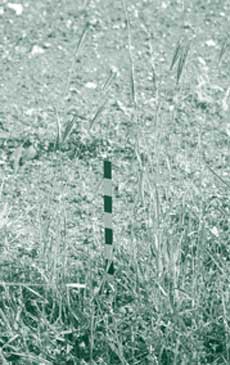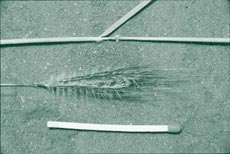
Dichanthium sericeum (Queensland bluegrass)
Description

Queensland bluegrass is a warm season perennial grass that is palatable to livestock. Some graziers report that sheep rarely graze this species and Dichanthium sericeum is perhaps more suited to cattle enterprises. In high rainfall years it is a high yield species, at least in terms of biomass production. In Queensland it can be baled for hay. This species is also considered one of the easiest native grasses to establish from seed and has a high rate of seedling recruitment. It is not particularly drought tolerant and in drier times, restricts itself to the wetter parts of the landscape.
Morphology
D. sericeum is easily distinguished in the field by its blue green leaf colour and nodes bearing a ring of erect, white hairs. A tufted erect perennial, 30–80 cm tall, generally rather slender. The spikelets (Spikelet - consists of one or more florets and is the basic unit of the inflorescence in grasses) are straw coloured, covered with silky hairs, and are often paired in the seed head. One spikelet of each pair is sessile (has no stalk) and is fertile and bears a twisted awn (Awn - an elongated bristle-like appendage attached to the apex, back or base of the glume, lemma or palea). The other member of each pair is stalked and is sterile. The culms (Culm - a grass stem) are erect, slender, densely branched at the base and often from the upper nodes as well, smooth and hairless. The leaves are well distributed and the leaf sheaths are round, close, at maturity and almost as long as the internodes. The leaf sheaths are usually hairless, but in some forms densely covered in white hairs. Ligules (Ligule - a membrane or hairs found on the inner (adaxial) surface of the leaf-blade/sheath junction) are short and membranous, ragged. Leaf blades flat, 8–15 cm long, 2–4 mm wide, often bluish-purplish, typically without hairs, but densely covered with white hairs in some forms and then the sheaths likewise, pointed from near the tip.
Distribution

D. sericeum is widespread in eastern and central Australia. Where it occurs throughout Queensland and New South Wales, it is readily eaten by stock and is considered one of the most productive native grasses. This grass is susceptible to frosts. D. sericeum prefers heavier clay soils or areas that capture a lot of moisture.
Vegetation associations
Commonly associated with Mitchell grass (Astrebla spp.) in western areas of Queensland and New South Wales and Bothriochloa decipiens (red grass) in the Hunter Valley.
Harvesting
Time
Harvesting period can occur after first summer rains through to March (NSW) and May (QLD), with peak production generally in February and March (depending upon seasonal rainfall). Under dry conditions seed can drop rapidly, reducing the window of opportunity in which harvesting can take place.
Methods
Brush harvesting is the most successful, as the inflorescence (Inflorescence - a group of flowers borne on a stem) ripens indeterminately. The action of the brush harvester only removes the ripened florets (Florets - the flowering part of a grass (includes the lemma and palea); the term is also used if some parts are absent and can refer to a lemma only), allowing for more than one harvest of a crop.
Seed storage
Seed should be stored in a cool dry place. Seed dormancy may be as high as 60%, however, this can be easily overcome by removing enclosing structures prior to sowing. Germination percentages (50–80%) are greatest for seed between 6–12 months of age. Tests have shown that germination can be substantially reduced after 4 to 5 years. Purity from wild stands is generally high (50–90%).
Sowing
Ideal conditions
Optimum temperatures for germination are between 20–30°C. This species does require wet conditions to germinate. If sowing under dryland conditions use fluffy seed otherwise naked seed can be used in irrigated conditions.
Methods
Ideally a fine seed bed should be prepared, however, successful stands have been established by broadcasting or using a band seeder both followed by light harrowing. Conventional seeding methods (small seed box and buffel drum seeder) have not been successful in sowing seed due to the fluffy and binding nature of the seed. The crocodile planter has been used to create pits, followed by broadcasting seed has resulted in successful establishment of D. sericeum in central western New South Wales.
Management
Slashing or mowing will help reduce weeds seeding, provide an excellent micro-environment for new seeds to germinate and will enable the control of even ripening for optimum harvest.
D. sericeum will rapidly recruit new seedlings given wet warm conditions. As a pasture, livestock preferentially graze it after rainfall. Individual plants will live for about 3–4 years and will tolerate moderate grazing.
Other species
- Astrebla lappacea (Curly Mitchell grass)
- Astrebla pectinata (Barley Mitchell grass)
- Austrodanthonia bipartita (Wallaby grass)
- Austrodanthonia caespitosa (White top)
- Austrodanthonia richardsonii (Wallaby grass)
- Bothriochloa macra (Red grass)
- Chloris truncata (Windmill grass)
- Elymus scaber (Common wheat grass)
- Heteropogon contortus (Black speargrass)
- Microlaena stipoides (Microlaena or Weeping grass)
- Paspalidium constrictum (Box grass)
- Paspalidium jubiflorum (Warrego summer grass)
- Themeda triandra (Kangaroo grass)

